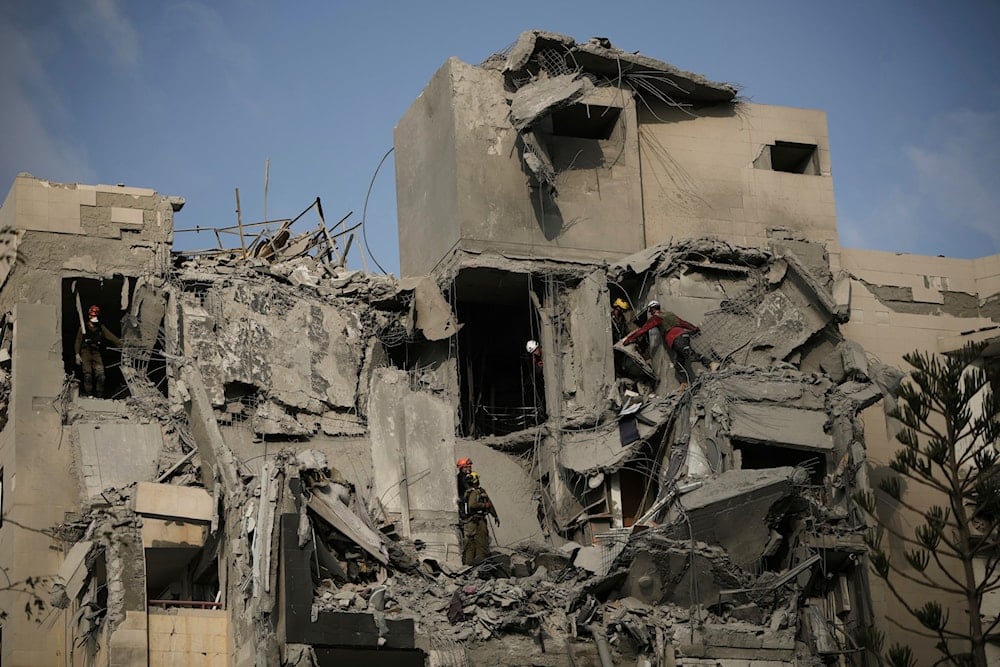In numbers: Iran's True Promise 3 devastates 'Israel' in 12 days
Over 530 Iranian missiles struck deep into "Israel", causing 29 deaths, thousands of injuries, and extensive infrastructure damage.
-

Israeli security forces inspect the site struck by an Iranian missile strike that killed several people, in Beer al-Sabe', occupied Palestine, on Tuesday, June 24, 2025 (AP)
A ceasefire between Iran and "Israel" went into effect on Tuesday, 12 days after the occupation launched its Operation "Rising Lion" and Iran launched its True Promise 3 retaliatory operation. What started as a campaign to dismantle Iran's nuclear program quickly backfired, heaving destruction upon "Israel" itself.
Since June 13, 2025, "Israel" faced heavy missile fire from Iran's Islamic Revolution Guard Corps, with over 40 missile barrages launched in the 12 days, totaling 531 missiles launched, 31 of which achieved direct hits. 29 Israeli settlers were killed and 2,517 others were injured across the entirety of "Israel".
Read More: 'Israel' is firing interceptors faster than it can produce them: NYT
IOF announce soldier killed in Beer al-Sabe'
The IOF announced the death of a corporal from its multi-dimensional 888 unit, killed during the Iranian missile strike that targeted Beer al-Sabe' in the south of occupied Palestine. This marks the first soldier fatality admitted by "Israel" throughout the 12 days.
The death toll from the Iranian missile strike on a building in Beer al-Sabe' has risen to nine, according to emergency services, as reports confirmed multiple injured victims were hospitalized with varying degrees of injuries following the attack that caused severe structural damage to the site.
Iranian missiles record numerous hits across 'Israel'
Iran's missiles directly hit multiple locations across "Israel", including major cities like Tel Aviv, Ramat Gan, Haifa, Beer al-Sabe', and Herzliya, as well as smaller areas such as Tira, Rehovot, Bat Yam, and Bnei Brak.
The strikes also struck industrial sites like oil refineries and reached areas along the coastal plain, including Rishon LeZion, Holon, and Azur.
Additional impacts were reported in Safad, Isud, Karmiel, and Shfaram, demonstrating the wide scope of the attack. Key infrastructure and areas were struck, with repeated hits on Tel Aviv, Ramat Gan, Petah Tikva, and Haifa.
120 missiles targeted 'Israel' in one day
June 14 marked the deadliest day of the war, with four separate rocket barrages of a total of 120 missiles striking central areas, such as Tel Aviv, Bat Yam, Tira, and Rishon LeZion, killing 12 people and wounding 200 others.
The very same day also saw the highest number of missiles launched in a single day, with a total of 120 missiles fired, while June 19 marked the broadest geographic spread of attacks, as strikes hit seven different areas, indicating a widening pattern of escalation.
Shelters failed to protect Israelis
Iran's missiles caused casualties even among Israelis who fled to shelters, with 29 fatalities reported by Israeli media, including some killed inside reinforced safe rooms, raising questions about either the capabilities of the missiles used or vulnerabilities in the defensive infrastructure.
The initial wave of attacks from June 13 until June 16 proved the most intense and deadly before transitioning into a phase of sporadic, less lethal strikes, as multiple reports indicated that the total number of wounded and injured across various classifications exceeded 2,517.
Magen David Adom (Israeli Red Cross) reported that its teams handled 28 fatalities and 1,319 injuries during the Iranian strikes on occupied Palestine, including 17 critical cases, 29 moderate injuries, and 872 minor wounds, along with 401 panic-related incidents.
Compensation claims flood 'Israel'
According to data from the Israeli Tax Authority, over 38,000 compensation claims were filed for property damage, including structural damage to buildings and losses of personal belongings; approximately 31,000 claims related to building damages, around 3,700 claims for vehicle damages, and nearly 4,000 claims covering household contents and other personal property losses.
The authority noted that thousands of damaged buildings have yet to be reported in compensation claims.
The compensation claims were heavily concentrated in the Tel Aviv metropolitan area (Gush Dan), which accounted for roughly 65% of all filings, around 25,000 claims, followed by 10,800 claims from the Askalan region, 2,600 from Akka, a surprisingly low 94 claims from al-Quds, and several hundred more scattered across smaller areas.
Approximately 11,000 people were relocated to hotels for temporary shelter, while nearly 4,000 others found accommodation with relatives, as displacement numbers continued rising throughout the war.
Israeli economy hit as hard as cities
According to the Israeli newspaper Calcalist, the estimated cost to cover damages through the compensation fund alone reaches approximately 5 billion shekels (around $1.44 billion). The newspaper noted that markets are projecting a government deficit exceeding 6% this year, far above the 4.9% of GDP ceiling set by the government.
The newspaper reported that markets are anticipating a government deficit exceeding 6% this year, significantly surpassing the 4.9% of GDP ceiling set by the government, as economic pressures from recent conflicts continue to strain public finances.
Israeli reports indicate the occupation forces have incurred approximately $5 billion in costs, roughly $725 million every day, for offensive operations against Iran and defensive measures to counter Tehran's missiles and drones.
Read More: Maersk Shipping halts Haifa port visits temporarily

 5 Min Read
5 Min Read










